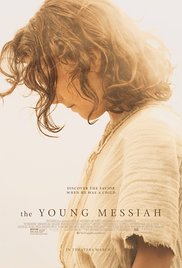
THE YOUNG MESSIAH
UK, 2016, 110 minutes, Colour.
Adam Greaves- Neal, Sean Bean, David Bradley, Jonathan Bailey, Rory Keenan, David Burke, Christian Mc Kay, Isabelle Adriani, Jane Laportaire, Vincent Walsh, Sara Lazzaro, Finn Ireland.
There is an unusual film phenomenon at the opening of 2016. Two films, Scripture-based, but imaginative interpretations of Gospel events.
Since 2000, have been many religious films, success attributed to Mel Gibson’s The Passion of the Christ. There have been quite a number of Jesus films: The Miracle Maker, Mary mother of Jesus, Jesus, The Gospel of John, the South African Son Of Man. It seems that there is an appetite in a wide range of audiences for Biblical films (more recently Noah and Exodus: Gods and Kings).The two films for 2016 are The Young Messiah, a film about Jesus at the age of seven, and Risen, a perspective on the death and resurrection of Jesus from the point of view of a Roman Tribune.
In the credits of The Young Messiah, the film is said to be based on a book by popular novelist Anne Rice. The director of the film, Cyrus Nowrasteh, an American with an Iranian background, co-wrote of the screenplay with his wife, Betsy Giffen Nowrasteh.
The important information, reassuring for faith audiences, is that the film is “inspired by, rooted in” the Scriptures. The film declares that it is an imaginative telling of the story.
The action takes place during Jesus’ seventh year. It opens in Egypt where Mary and Joseph have stayed until they have news, especially in Joseph’s dream, that Herod who had persecuted Jesus and killed the Innocents, has died. The family are living in Alexandria with other refugees from Judaea, especially the family of Clopas, his wife and his son, Jesus’ cousin, James.
Audiences will find this visualising of life in Egypt a helpful filling in background. Jesus is played by a young British boy, Adam Greaves- Neal, giving a fairly serious performance, perhaps wise beyond his years but not understanding quite who he is, his parents not having given him much background of his origins, a boy who is asking questions but who also has moments of play. One of the local boys is a bully and Jesus help save a girl from the bullying when the boy himself trips and dies – Jesus being blamed, but going to visit the boy, touching him and the boy reviving. Joseph is concerned as his Mary and they feel that it is time to return to Nazareth.
Sean Bean plays a Roman Centurion, reporting to the new king, the young Herod Antipas, who remembers the heritage of his father, is superstitious and consults witches, but has heard rumours of the healings of the young Jesus and wants to see him. The role of the Centurion and his men is to hunt down rebels and, as the family make their way towards Nazareth, they encounter the Romans and the Centurion allows Jesus and family to go on their way.
The family eventually arrive in Nazareth, after another healing episode (of Clopas) at the Jordan, then are welcomed by Sarah, and Jesus makes a great impression with his knowledge of Scripture on the local rabbi who knew Jesus’ parents before he was born. But Jesus, still consumed with a desire to know more about who he is, fostered by James telling him the story of the Magi, asks permission of Joseph to go to Jerusalem. In this sequence, the film anticipates Jesus at age 12 and recounts the story of Jesus, meeting the rabbi in Jerusalem (but also healing him of blindness), Mary and Joseph looking for him.
In the meantime, the Centurion receives information about Jesus and his family, that he is in Jerusalem and makes an effort to find him – which he does, but let him go.
This is a Faith film but not one preachingly so. Allowing for the fact that it is all reverent imaginative speculation, the film will probably be acceptable to most audiences – and is the kind of film that could be useful for parish groups and school classes, especially for younger children.
Risen, mentioned earlier, focuses on Jesus death and resurrection from a Roman perspective.